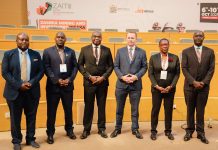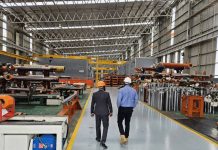Zambia has aspirations to be a prosperous middle-income country within just a few years, by 2030. Government, the private sector, and multi-lateral institutions like the World Bank Group all agree on one thing: harnessing the country’s endowment of critical or “energy transition minerals” (ETM) will be central to achieving this goal.
But what exactly needs to happen in order for Zambia to grow its mining sector, achieve its ambitious production target of three million annual tonnes of copper, and seize the once-in-a lifetime opportunity that rising demand for cobalt and other critical minerals presents?
As with any destination, reaching this point will require a map. This is precisely the purpose of a newly-launched ‘roadmap’ – called Repositioning Zambia to Leverage Energy Transition Minerals for Economic Transformation: A Roadmap – created by the World Bank Group (WBG) in collaboration with the Government of Zambia, launched in Washington DC on 23 April.
What kind of ‘roadmap’ is this?
This extensive data-driven report was compiled at the request of Zambia’s Minister of Finance and National Planning, Hon. Situmbeko Musokotwane, by over 100 experts and WBG consultants over many months. The minister’s requirements were clear from the start: the report must be a joint product with the Government of Zambia, and should be practical when it comes to its implementation.
It consists of “a deliberate, whole-of government approach and an integrated strategy for leveraging Zambia’s ETM resources for economic transformation, focusing on maximizing the generation, sharing, and management of benefits and minimising risks,” reads the report. It also provides “a menu of policy recommendations to address these challenges, along with proposals for implementing the roadmap.”
These recommendations extend across areas including mining, energy, transport, skills, value addition, local content and environmental sustainability – with actionable steps and specific lead agencies within each chapter.
Dr Martin Lokanc – Senior Mining Specialist in the World Bank’s Energy and Extractives Global Practice, and one of three of the report’s lead coordinators – points out that it will take “more than just the Ministry of Mines” for Zambia to achieve its ambitious growth target – simply because the sector is not disconnected from everything else.
“Energy in particular needs to grow along with mining, especially if you want to have value addition – and transport constraints need to be addressed too,” he says. “If Zambians want to participate directly, we need to generate the skills of the future – and in time. But we also need to promote local supplier development and adopt tried and tested ‘local content’ policies that enable SMEs [Small and Medium-Sized Enterprises] to create those backward and forward linkages – not only in batteries, but also in simpler things like copper fabrication. But economic development cannot happen at the cost of the environment or communities, and all of this has to be reinforced by Government at the same time. That’s why the roadmap approach really is a ‘whole-of-government’ approach.”
“If Zambians want to participate directly, we need to generate the skills of the future – and in time. But we also need to promote local supplier development and adopt tried and tested ‘local content’ policies that enable SMEs to create those backward and forward linkages.”
What will Zambia gain by implementing this roadmap?
If implemented fully and rigorously, the impact of following this roadmap will be far-reaching. It will triple mineral production, yielding a 3-4 times increase in Government’s fiscal take from the mining sector, which can be invested into infrastructure, education and health for all Zambians. It will create hundreds of thousands of quality jobs. Direct mining employment in particular could quadruple to approximately 200,000, while the country stands to gain more than 300,000 indirect or induced jobs across industries like services, logistics and manufacturing. In short, leveraging Zambia’s mineral wealth in this way will completely transform the economy.
If implemented fully and rigorously, the impact of following this roadmap will be far-reaching. It will create hundreds of thousands of quality jobs.
What’s next?
Taking the roadmap to Cabinet in order to enable its implementation is the next step. Financing the roadmap is also vital. This will require a sum of US$14 billion by 2030, most (89%) of which needs to be privately financed. This figure expands to US$32 billion by 2040 for full value-chain build-out, said Secretary to the Treasury Mr Felix Nkulukusa, who presented some of the key takeaways to a group of donors and would-be funders during the roadmap’s launch at the 2025 World Bank Group – IMF Spring Meetings in Washington, DC.
This represents Foreign Direct Investment (FDI) that’s unlike anything Zambia has seen before. Securing the funds to enable the implementation of this roadmap will take Zambia on a trajectory from where it is to an entirely different strata, putting it in a league with thriving middle-income mining countries around the world.
Naturally, fiscal and policy stability are non-negotiable when you’re looking to attract capital of this magnitude. It’s equally critical to create a conducive investment climate to attract private sector participation at scale.
“A great new era awaits for critical minerals, the benefits of which hinge on the quality and stability of policy and regulatory responses”, H.E President Hakainke Hichilema declared at the March launch of the ‘Zambezi Minute,’ a parallel initiative aimed at harnessing the global demand for critical minerals and attracting foreign investment.
“If you look back to Independence, Zambia has never had a multi-decade stable plan for the mining sector,” points out Mr Sokwani Chilembo, CEO of the Zambia Chamber of Mines. “In the past, we failed to adhere to a plan, hence the outcome. Now we finally have a plan and – going by the experience of countries like Peru, Chile, DRC and Botswana – if we stick to it, we are sure to do much better in terms of improving our human development index score.”
The WBG and Government’s collaboration via this optimistic new roadmap, he says, is an exciting step in the right direction.
***
Stay tuned for a series of follow-up articles that dives deeper into the roadmap’s recommendations and action plan – from how best practice in areas like local content are essential for growing the sector, to what it will take to give land-linked Zambia the edge it needs – along with comments from a range of stakeholders.
The broader macro-fiscal impacts of implementing the roadmap will be discussed in an upcoming World Bank Zambia economic update, which we’ll share on our social media channels when it’s released. You’ll find the full roadmap online here and an Executive Summary here.
Keep an eye on our website and social media platforms, or email info@miningforzambia.com to receive a message the minute the next instalment is published.
See also: Taking the temperature of the room
























